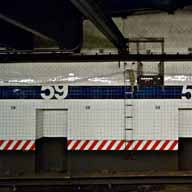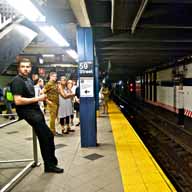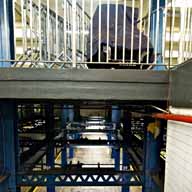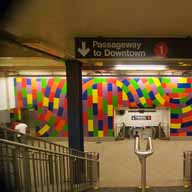nyc subway | columbus circle (a/b/c/d trains)
07/26/2015Back to columbus circle, this time for the A/B/C/D train platform. These trains were part of the IND line, and were built later than the IRT 1 train previously discussed, and Columbus Circle is one of the major transfer points between different lines in the system. The platform itself, being part of the IND and newer, doesn’t have mosaics that are as interesting as the IRT platform, but they do have useful, large “59” tiles identifying the station.
In addition, this side of the station, at the mezzanine level, includes a large colorful mosaic by Sol LeWitt titled “Whirls and Twirls”.
This station also highlights one of the unique features of the New York City Subway system – the NYC Subway is (I believe) the only system in the world that runs multiple different train lines along the same tracks. you can see that in this station, which has 4 lines running along 2 tracks. The “color coding” that was instituted when the systems were all merged were to help identify where trains shared “core” tracks – So the B/D are orange, and run south of columbus circle along 6th avenue (and are joined by the F/M trains), and the A/C are blue and run along 8th avenue (where they are joined by the E train below 50th street from queens). But north of columbus circle, the A and D go on the express track, while the B and C run on the same local track for the length of central park west until they split again after 145th street. The color coding gives the impression that they are the “same” train, but if you actually look at a map, you can see that each individually numbered train often starts and terminates in a completely different place, and there are places where different “colors” essentially merge for sections of the map. In places like London and Paris, you may see a local and express train run together, a particular line that has two “branches” where it will split in two potential destinations near its end, but I think NY is the only (or was the first) system that is designed to run multiple lines on multiple tracks. This also makes the system surprisingly flexible (given its age and funding issues) and able to divert trains to different tracks during construction and emergencies.
The only caveat – you cannot run an BMT train car on an IRT track. the IRT trains were narrower than the BMT trains. The tracks are the same width, but the tunnels are not, so BMT trains are too wide to fit in an IRT tunnel.
Station opened: September 10, 1932
Original system: IND
Trains: A/B/C/D
Source/More info: Wikipedia








